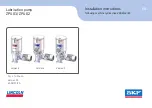
Water Tec Int’l. Inc. Version 02A
3
INTRODUCTION TO REVERSE OSMOSIS
The application of reverse osmosis to the solution of problems in water treatment requires an understanding of the
basic mechanisms involved in the process, the limitations of reverse osmosis and the pre-treatment requirements.
HOW REVERSE OSMOSIS WORKS
Reverse Osmosis (RO) is the process in which water is forced by pressure through a semi-permeable membrane.
Water passes through the membrane while the dissolved and particulate materials are left behind. When pressure is
applied to the concentrated solution, water is forced through the membrane from the concentrated side to the diluted
side. The spiral membrane is constructed of one or more membrane envelopes wound around a perforated central
tube. The permeate (product water) passes through the membrane into the envelope and spirals inward to the central
tube for collection.
THE MEMBRANE
Reverse Osmosis utilizes the unique properties of a semi-permeable membrane to allow fluid to pass while
restricting the flow of dissolved ionic material. With pressure applied to impure water on the side of such membrane
materials, pure water will pass through, leaving most of the impurities behind. The rejection of the dissolved ionic
material is a function of both molecular weight and ionic charge. For example, we can expect a nominal 90% rejection
of sodium chloride, which means that the product water passing through the membrane will have a concentration of
salt approximately one-tenth that of the feed water. The rejection of calcium carbonate (hardness) will be near 95%,
while most metallic salts will be rejected at a rate of approximately 98% to 99%.
The rejection of non-ionic or organic material is primarily by mechanical filtration. Most substances with a
molecular weight of over 100 will be completely rejected by an intact reverse osmosis membrane. Low molecular
weight organics, such as formaldehyde or phenol, can pass freely through an R.O. membrane, as can most dissolved
gasses. Oil, suspended solids and particulate matter are mechanically filtered, as are viruses, bacteria, pyrogen, and
larger organic molecules.
To carry the rejected material away from the membrane surface, the feed side of the R.O. membrane is
continually flushed with an excess flow, usually two to five times the product flow. This avoids clogging of the
membrane surface and reduces the tendency toward scale formation.




































